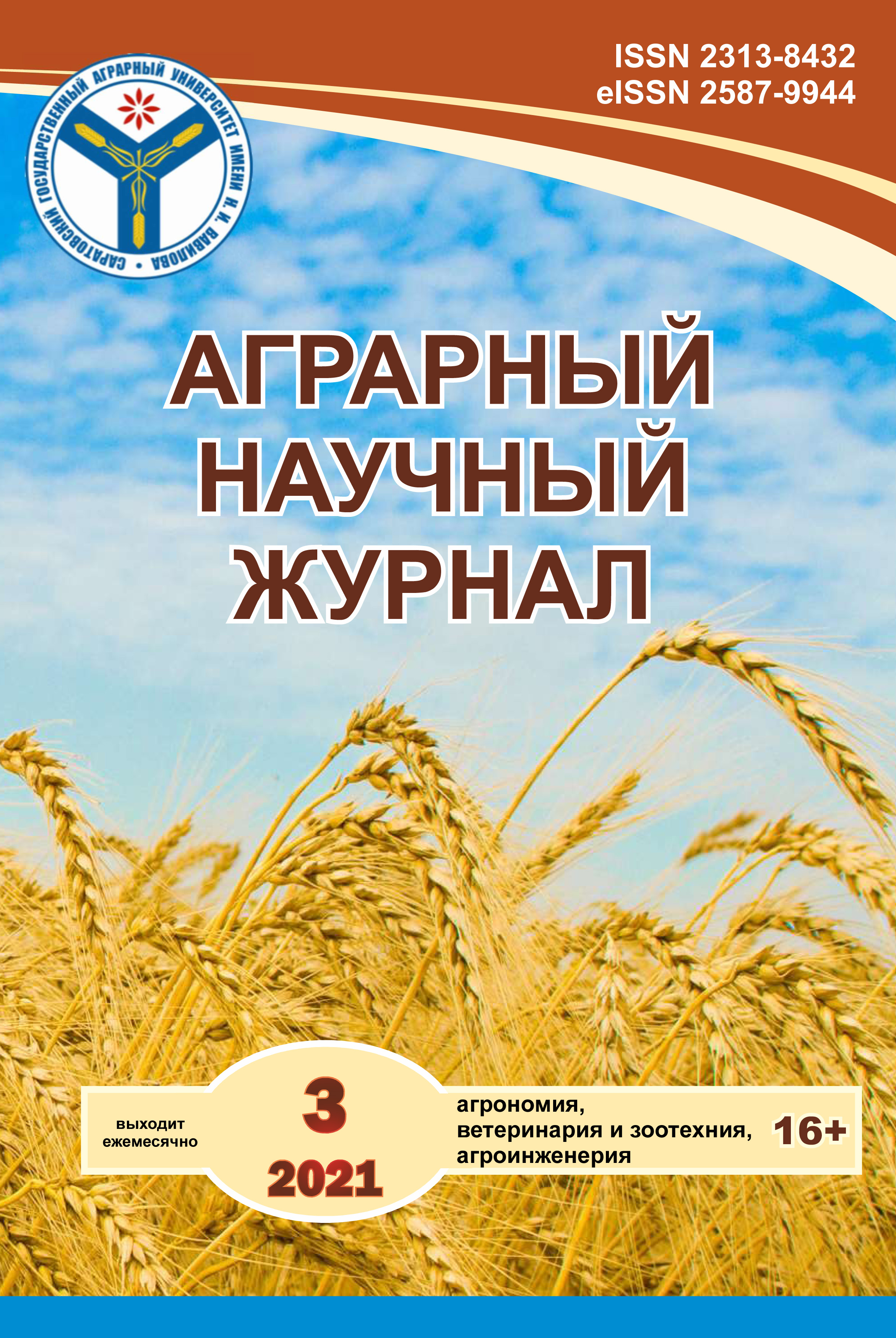The influence of treatment by different microorganisms on the development of alternariosis (Alternaria solani) and the potato yield
DOI:
https://doi.org/10.28983/asj.y2021i3pp4-8Keywords:
potato alternaria, biological control, microorganism, Trichoderma, BacillusAbstract
Alternariosis is a dangerous disease of potatoes, which reduces its production in Russia and abroad. Due to the intraspecific variability of the pathogen, wide symptoms and a long period of immunity, it is very difficult to diagnose the disease and take protective measures. As a biological method of protection, eight microorganisms have been tested with an effect on alternaria (Alternariasolani (Ell. Et Mart.). Sor.); these bioagents were screened for their disease inhibitory activity in the field. Studies have shown that the treatment of potatoes with Trichoderma sp. and Bacillus thuringiensis showed a high value for the increase in plant size in both cultivars (44.6, 43.1 cm for Romano), (47.6, 42.7 cm for Labella) compared to control. The number of stems in plants treated with Pseudomonas jessenii was higher (4.0, 4.4 pcs) than in the control of both varieties. Potato processing Trichoderma sp. and Bacillus thuringiensis reduced the spread of the disease in the studied cultivars (23.0, 24.6% for Romano), (17.4, 20.3% for Labella) compared to controls. Treatment of potatoes with Trichoderma sp. and Bacillus thuringiensis increased the weight of the marketable yield on both varieties (18.1, 17.1 t / g for Romano), (19.8, 19.2 t / g for Labella) compared to the control.
Downloads
References
Ганнибал Ф.Б. Мониторинг альтернариозов сельскохозяйственных культур и идентификация грибов рода Alternaria. Методическое пособие. – СПб., 2011. – 72с.
Комплексное применение биологических и химических препаратов против альтернариоза картофеля в орошаемых условиях Волго-Ахтубинской поймы / О.Г. Корнева [и др.] // Аграрный научный журнал. – 2020. – № 11. – С./
Станчева Й. Атлас болезней сельскохозяйственных культур. Т. 4. Болезни технических культур. – София-Москва, 2003. – 185 с.
Шабанова И.О. Биоэкологическое обоснование защиты картофеля от альтернариоза в лесостепи Среднего Поволжья: автореф. дис. … канд. биолог. наук / Шабанова Ирина Олеговна. – Кинель, 2011. – 21 с.
Borneman J. and Becker J.O. Identifying microorganisms involved in specific pathogen suppression in soil // Annual Review of Phytopathology, 2007, No 45, P. 153–172.
C?t? J.-C., Vincent C., Son K.-H. and Bok S.H. Persistence of insecticidal activity of novel bioencapsulated formulations of Bacillus thuringiensis var. kurstaki against Choristoneura rosaceana [Lepidoptera: Tortricidae] // Phytoprotection, 2001, Vol. 82, Р. 73–82.
Dennis C., Webster J. Antagonistic properties of species groups of Trichoderma. I. Production of non-volatile antibiotics // Trans. Br. Mycol. Soc., 1971, Vol. 57, Р. 25–39.
Gaskill J.O. Breeding for Rhizoctonia resistance in sugar beet // J. Am. Soc. Beet technol, 1968, No 15, P. 107–119.
Genzel F. The molecular basis of the plant-pathogen interaction of potato and Rhi-zoctonia solani: dissertation PhD. – Berlin, 2017. – 167 p.
Ghildyal A., Pandey A. Isolation of cold tolerant antifungal strains of Trichoderma sp. from glacial sites of Indian Nimalayan Region Research // Journal of Microbiology, 2008, Vol. 3(8), P. 559–64.
Montealegre J., Valderrama L., S?nchez S., Herrera R., Besoain X., Perez L. Biological control of Rhizoctonia solani in tomatoes with Trichoderma harzianum mutants // Electronic Journal of Biotechnology, 2010, Vol. 13, Р. 1–2.
Mukerji K., Garg K. (1988). Biocontrol of plant diseases. Boca Raton: CRC Press. – URL: https://doi.org/10.1201/9780429292347.
Osbur R.M., Milner J.L., Oplinger E.S, Smith R.S., Handelsman J. Effect of Bacillus cereus U W 85 on the yield of soybean at two field sites in Wisconsin // Plant Dis., 1995, No 79, P. 551–556.
Raziq F. and Ishtiaq S. Integrated control of Alternaria solani with Trichoderma spp. and fungicides under in vitro conditions // Sarhad Journal of Agriculture, 2010, Vol. 26, Р. 613–619.
Umamaheswari B., Thakore B., More T. Post-harvest management of ber (Ziziphus mauritiana Lamk) fruit rot (Alternaria alternata (Fr.) Keissler) using Trichoderma species, fungicides and their combinations // Crop Protection, 2009, Vol. 28 (6), Р. 525–32
Downloads
Published
Issue
Section
License
Copyright (c) 2021 The Agrarian Scientific Journal

This work is licensed under a Creative Commons Attribution-NonCommercial 4.0 International License.








